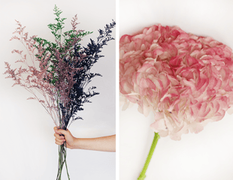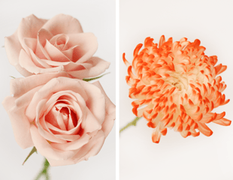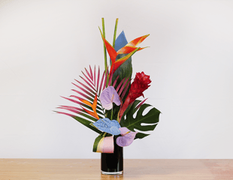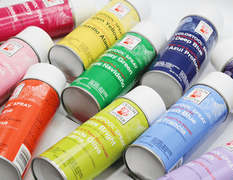Before mixing painted flowers into your next design, it’s important to consider which spray is the best to use and all the creative ways it can be utilized.
3 Ways Van Gogh’s Flowers Can Inspire Your Painting
There are so many ways that painters can pull inspiration from Vincent van Gogh’s decade of painting. I recently posted about 6 ways van Gogh can make you a better artist . But today I want to look at one facet of van Gogh’s paintings—his many paintings of flowers—and how they can be a powerful inspiration for painters.
Painting flowers was a way for van Gogh to transition from the use of dull, somber colors to bright, bold colors. He used his floral paintings as color studies. In particular, he enjoyed creating bold contrast using complementary colors in some of these paintings, such as red roses on a green background, blue irises on a yellow background, or yellow flowers on a purple background.
So even if you’re thinking that you don’t plan to become known for your floral paintings, flowers are the perfect starting point for color studies. The more you experiment with color studies, the more mastery you’ll achieve—which will benefit you no matter what subject matter you plan to specialize in!
Be Open to Variety
You may think of sunflowers when you hear “van Gogh’s flowers.” But in fact he painted a wide variety of flowers beyond sunflowers: irises, roses, peonies, poppies, chrysanthemums, lilacs, daisies, and more. Van Gogh was also open to painting flowers at all stages of their life cycle, from fresh blooms to wilting. Each flower had something to teach him!
I urge you to take photos of flowers that you see near your home. Take a day and go to your local botanical garden, garden center, or historical garden to encounter a wide variety of flowers. At a minimum, look at seed catalogs or online photos of flowers to determine which ones are the most interesting to you. And don’t forget to keep an open mind when flowers are “past their peak.” You’ll find that aging flowers (just like aging people) still have a beauty all their own.
Take a Deep Dive into Painting Flowers
Van Gogh developed his style by painting at a feverish pace. For example, in the summer of 1886, he painted 30 floral still lifes! The more he painted, the more he developed his color sense and his brushwork.
Now imagine what you could learn if you committed to a floral “deep dive” painting series! You could paint 10 floral still lifes that focus on one or two types of flowers in different compositions. Imagine how that would impact your relationship with and understanding of that type of flower and the powerful boost to your art skills it would give you! I challenge you to go deep into this subject as van Gogh did. See what you learn!
Design Master
An industry favorite, Design Master has several lines of flower-friendly dyes and paints. In the video tutorial below we use their COLORTOOL line. It’s a fast-drying spray with a wide range of colors, including metallic! Their most versatile line, COLORTOOL sprays can be used on fresh, silk or dried flowers, containers, ribbon, wood, and a variety of other surfaces. Another wonderful line by Design Master is their “Just For Flowers” sprays. These are essentially flower dyes in a can. They’re best for enhancing natural color, as the spray allows for the flower details to shine through.
What makes Design Master the best? Aside from myriad color choices and versatility of uses, the ingredients are top-notch. They are environmentally friendly (no harm to the ozone layer) and use a modified lacquer-based product. This means that when you’re applying multiple coats, the layers will bond together instead of sitting on-top of one another – allowing you to combine several colors and create different effects with a perfect blend. The creative possibilities are endless!
Painting Techniques
There are several ways to include spray paint in your floral designs. Use it to highlight certain blooms or add a subtle pop of color. Create geometric designs using tape or a monochromatic look from your customers color request. Whichever way you choose to incorporate floral paint, first consider these four spraying techniques:

Misting
The best way to paint the entire surface of the flower is by misting. Start by holding the can 15″ to 18″ away from the bloom, turning it as you spray. You can repeat this process several times, depending on the intensity of color you’re looking for. Once you’ve reached your desired color, gently shake the flowers to ensure all petals are hit and blended well.
Airbrushing
Similar to misting, the airbrushing technique is a good way to cover the entire surface of a flower. It can also be used as a way to highlight or darken target areas of the bloom. You’ll want to hold the can at least 20″ away for successful airbrushing.

Toning
If you want to enhance the natural coloring of a flower or cover up any imperfections, use the toning technique. Choose a paint color that is either the same shade of the flower or one shade darker or lighter. This will help bring out those natural colors and it will be impossible to tell what’s painted (and what’s not).
Tipping
Coloring by “tipping” is simply painting the tips of the petals. This technique works best with flowers such as spider mums and carnations. Hold the flower head in one hand and gently cup the petals together towards the center. Make sure only the tips of the petals are exposed and spray till the desired color is achieved.
Design tutorial
In the tutorial below, we chose to create an arrangement with tropical flowers. The naturally bright colors of tropicals are often a perfect match for floral paint. We used Design Master’s COLORTOOL in Perfect Pink, Raspberry, Hyacinth, and French Blue to transform the greenery and anthurium. Combined with the already vibrant heliconia and pink cone ginger, the end results give you an arrangement bursting with color!

How are you using spray paint to enhance your designs? Tag us in your photos on Facebook & Instagram!

Kayla Neary is the Marketing Coordinator for Kennicott Brothers. She holds a Bachelors degree in Communications from The University of Alabama and has previous experience as a retail florist.





